Writing has been independently invented only a few times in human history, including twice in the Near East, corresponding to the two fertile river valleys where agriculture and cities also arose largely independently - hieroglyphics were developed in the Nile basin in modern Egypt, and cuneiform in the "fertile crescent" between the Tigris and Euphrates in modern Iraq.
Both of these, like all writing systems invented by cultures with no prior knowledge of written language, are primarily logographic, meaning that the core symbols represent individual words. These logographies, which had thousands of symbols and used convoluted and inconsistent phonetic tricks to form words, were prohibitively baroque - they prevented widespread literacy and were nearly impossible to adapt to other languages (although the Assyrians, possibly motivated by a cultural reverence for their Sumerian forbears, did adapt cuneiform to writing the Akkadian language). Enter the Phoenician alphabet, the first alphabetic system to achieve widespread use.
The Phoenician alphabet is ultimately a derivative of the so-called proto-Sinaitic or North Semitic script, which holds the lofty claim of the world's first known alphabet. It was originally just a specific set of hieroglyphs used to represent just their first sound like an alphabetic letter, though after generations of hands writing over a millennium the forms eventually got more cursive. It contains 22 symbols, all primarily representing consonants, meaning that much like the modern Hebrew and Arabic systems it can technically be considered an abjad, an alphabet which doesn't write out short vowels. From the beginning it had three apparent advantages, two linguistic and one political. First was the nature of the alphabetic system itself - the straightforward, sequential encoding of sounds could be quickly learned by merchants or commoners who weren't scribes by training, and ensuring that it could be taken up at the helm of commerce and spread quickly to illiterate societies. Secondly, because the script was designed for Phoenician, it was also well suited to its close cousins in the Semitic language subgroup like Aramaic, Arabic, and Hebrew. When the Assyrians and later the Achaemenids took up Aramaic as their common language, an abjad derived from the Phoenician alphabet came with it, permanently establishing this lineage as the dominant way of writing in Southwest Asia. Lastly, there was the advantage conveyed by the fact that the Phoenicians were a society of merchants and sailors. Phoenicia itself refers to a culturally, economically, and linguistically (though never politically) unified civilization originating in the eastern Mediterranean in modern Jordan, Syria, and Israel, whose merchants and craftsmen developed advanced sailing technologies and established economic colonies across southern Europe and North Africa. In legend the Phoenician prince Cadmus brought writing to the Greeks; in one way or another the Greeks were eventually writing with their own modification of the Phoenician system, and they in turn passed the invention of writing to the rest of Europe.
All told, nearly every writing system in the world can be traced to the Phoenicians. In the Fertile Crescent it was precursor to the Coptic, Aramaic, Hebrew, and Arabic abjads. Aramaic was probably the ancestor of Asoka's Brahmi, which gave rise to the Brahmic abugidas that dominate South and Southeast Asia. Conversely, the Greek alphabet was modified by St. Cyril to create the Cyrillic alphabet used for most Slavic languages and a number of Turkic, Caucasian, and other Central Asian languages, as well as by the Etruscans and by extension Romans, whose monstrous cultural legacy means that people from Indonesia to Ireland to the Amazon now write their native languages in the Latin alphabet you're reading right now.
 Further reading:
Further reading:Hieroglyphics
Cuneiform
Northern Semitic
Phoenician
http://phoenicia.org
Phoenician Civilization
History of the Alphabet
Writing System Map

Lol
ReplyDelete